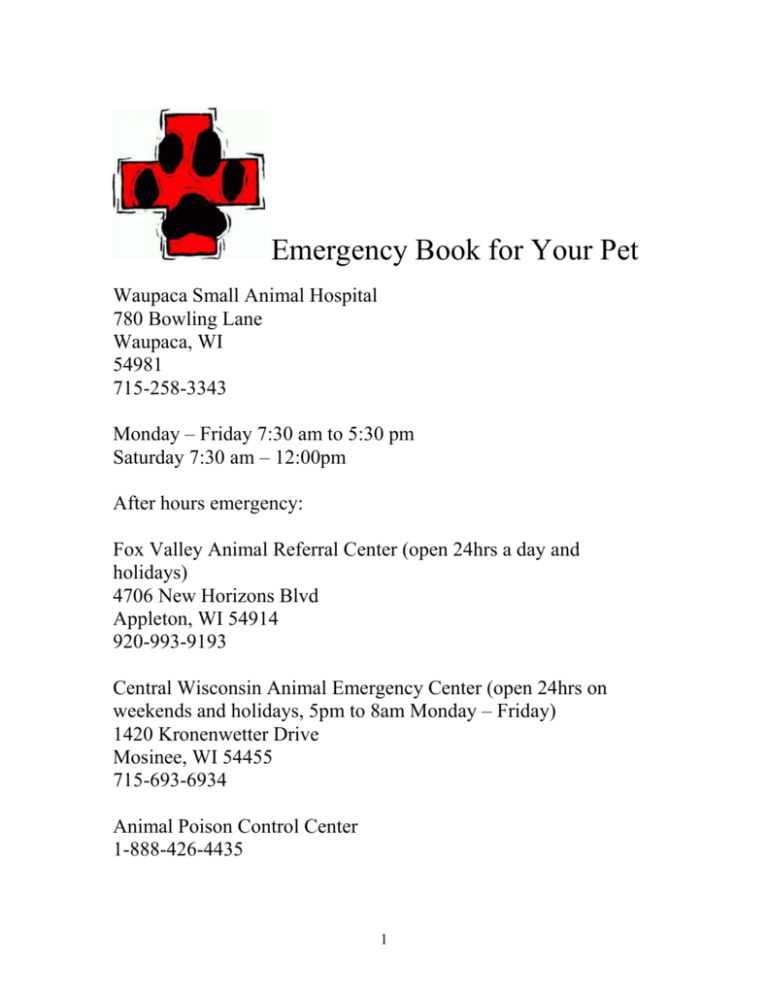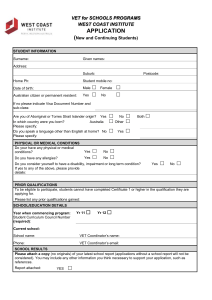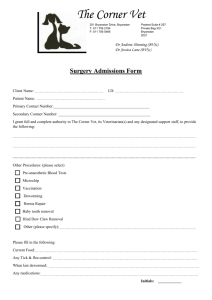Emergency Book for Your Pet - Waupaca Small Animal Hospital
advertisement

Emergency Book for Your Pet Waupaca Small Animal Hospital 780 Bowling Lane Waupaca, WI 54981 715-258-3343 Monday – Friday 7:30 am to 5:30 pm Saturday 7:30 am – 12:00pm After hours emergency: Fox Valley Animal Referral Center (open 24hrs a day and holidays) 4706 New Horizons Blvd Appleton, WI 54914 920-993-9193 Central Wisconsin Animal Emergency Center (open 24hrs on weekends and holidays, 5pm to 8am Monday – Friday) 1420 Kronenwetter Drive Mosinee, WI 54455 715-693-6934 Animal Poison Control Center 1-888-426-4435 1 Vital Signs Heart Rate : You can either place your hand or a stethoscope on their chest right behind their elbow, or you can also feel their pulse on their inner thigh toward the top of the leg (groin area). It’s a good thing to try sometime so not only do you know where on your pet is easiest for you to find the heart rate, but also get a feel out what is a normal heart rate for your pet. Normal resting heart rates: Cats Puppies Small Dogs Med to Large Dogs 130 - 220 beats per minute 120 - 160 beats per minute 100 - 160 beats per minute 60 - 100 beats per minute Breathing Rate: Normal breathing rate at rest Dogs Cats Temperature: Normal Temp: Dogs Cats 10 – 30 breaths per minute 20 – 30 breaths per minute The most accurate temperature is using a digital rectal thermometer. 100 – 102.5 degrees Fahrenheit 100 – 102.5 degrees Fahrenheit Remember that these are only general guidelines for cats and dogs. Things like exercise and ambient temperatures can cause variations in a pets vitals. These are guidelines so you as a pet owner have an idea of what normal is and it’s a good idea to see what is the normal rate for your pet, so you have a baseline to go off of. It is best to call a veterinarian if you have any questions or concerns. 2 Pet Emergencies Abdominal Pain: Symptoms- Whining, restlessness (can’t get comfortable), arching back, vomiting, diarrhea, bloated or distended belly, or lethargy. What to Do – Do not give your pet food or water. Let your pet rest and call a vet as soon as possible. Abdominal pain can be very serious and can be life threatening if not addressed. Allergic Reactions: Symptoms – Hives, swollen face, scratching, fever, diarrhea, vomiting, chewing on feet or difficulty breathing What to Do: Call a vet as soon as your see signs (especially facial swelling or breathing problems). Some reactions can be mild, but can escalate into emergencies if medication is not given to stop the reaction. Sometimes medications can be given at home for mild allergies (see Pet First Aid Kit) Bite Wounds: What to do: The biggest problem with an animal that is injured is that they are scared and hurt and may unwittingly strike out at you. Approach the animal slowly and calmly. Muzzle or hold the animals head while examining the animal’s bite wound. Make-shift muzzles can be made from a leash or a bandana to keep you and the animal safe for the exam and if you have to pick them up. Check for punctures and remember that there can be damage and bleeding under the skin even if there isn’t an open wound. If you can not get to a vet immediately, rinse the wounds out with saline and wrap wounds in a non-clinging material (do not use tourniquets or tape to stop bleeding). Use firm pressure to help stop the bleeding. Take the animal to a vet as soon as possible for treatment and to prevent infection. 3 Burns: What to Do: There are many different kind of burns from chemical burns to thermal (heat) burns to sun burn. If you can not get to a vet immediately, flush area with cool water for 5 minutes (do not use ice packs directly on skin because this can cause further skin damage). Then apply a cool compress or towel wrapped ice pack to burn area. Then call a vet immediately for treatment and to prevent shock. Cardiac (Heart) Emergencies: Symptoms: Collapse, blue/gray gums, rapid/slow heart rate, respiratory distress, or weakness What to Do: Call a vet IMMEDIATELY. Cardiac emergencies are very serious and should be treated as soon as possible. Limit the animals activity , carrying them when needed. If the animal stops breathing, begin CPR (see back of this booklet). Cold Emergencies (Hypothermia/Frostbite) Symptoms: Shivering, weakness, lethargy, blue/gray areas of skin, inability to use limbs What to Do: Bring the animal inside and start to slowly warm them. Take a rectal temperature to get a baseline (remember normal is 100- 102.5 degrees). To warm the animal warm/dry blankets and/or warm water bottles wrapped in towels( you can warm the blanket/towels in the dryer first). DO NOT use electric blankets or heating pads because these can cause even more skin damage or even burns. The key is to slowly warm the animal and transport them to a vet for an exam/treatment. 4 Diarrhea What to Do: There are many causes of diarrhea from stress to food changes to more serious conditions like internal parasites or disease. Make sure that the animal keeps drinking to avoid dehydration. You can make a bland diet made of boiled hamburger or boiled chicken and white rice. This a very bland/easy diet for them to digest and can help sometimes with mild cases. If the diarrhea continues for more than 24 hours or the animal becomes lethargic or stops eating, it should be seen by a vet. Eye Emergencies Symptoms: Squinting, discharge (watery or yellow/green), redness, different sized pupils, swelling What to Do: If there is a laceration or foreign object in eye, seek veterinary care immediately for treatment. Do not try to pull foreign object from eye, especially if it has pierced the eye. If the animal has dirt or has been exposed to a chemical irritant, you can flush the animal’s eye with sterile saline and then call a vet. Eye infections and eye injuries can get worse quickly, so it is important to have the eye looked at soon after you notice a problem. Fractures Symptoms: Not using limb, limb looks bent or swollen, whining, dragging or scooting across floor, unable to walk, bone protruding What to Do: The animal will most likely be in pain, so be careful moving them (you may have to muzzle them to be safe). If there is any bleeding, apply pressure with a towel, but try not to move limb. Try to stabilize limb with a stiff material like cardboard or rolled newspaper. Call a vet to have animal seen as soon as possible. 5 Heat Emergencies (Hyperthermia) Symptoms: Excessive panting and drooling, lethargic, unable to stand, vomiting, diarrhea, bright red gums What to Do: Move animal to a cool area as soon as possible, keeping them calm. If there is water nearby, have animal stand of lay in cool water, but do not give them a cold bath (rapid cool down can cause more damage or cause them to go into shock). Cool compresses or wet towels can be used between legs and on chest. Call a vet to have pet seen for any addition supportive care. Lacerations What to Do: Be careful when approaching animal and examining wound. Look closely for wounds (may be hard to find under fur) and bruising. Flush lacerations with sterile saline and control any bleeding with bandaging or wraps and non-sticking gauze. Apply firm pressure when wrapping. Transport animal to a vet to have further treatment. It is important to have lacerations treated immediately to avoid infection and so they can be sutured (if needed). Older wounds may have to be treated with medication before being repaired and may require more than one surgery to remove infected tissue. Neurologic Emergencies Symptoms: Inability to use limbs, unable to stand, circling, head tilt, dragging limbs or “knuckling” where they will stand on the tops of their feet What to Do: If these symptoms are seen, call you vet to have the animal seen. If the animal is having a hard time walking, you can use a towel looped under their belly to help them walk. 6 Poisoning Symptoms: Vomiting, seizures, retching, excessive drooling, disorientation, pale gums What to Do: Call a vet immediately. If you know the source of the poison, keep the package and have it handy when you call. Do not make the animal vomit until you consult the vet, because certain poisons can burn the throat and mouth on the way back up. It you are instructed to make the animal vomit by the vet, give a shot glass worth of hydrogen peroxide every 5 minutes until they vomited up the poison. If the source of the poison is not known, take the animal to a vet immediately so anti-toxin treatments can be started. The sooner they are treated, the less poison is absorbed. Many times by the time you wait to see symptoms like seizures, or disorientation, it is too late. Animal Poison Control Center 1 -888-426- 4435 ASPCA website (poison lists) Respiratory Emergencies Symptoms: Collapse, weakness, blue/gray gums, labored/rapid/shallow breathing What to do: Call a vet immediately. There are many things that can cause difficulty breathing from allergic reactions to foreign bodies to trauma. If you can see a foreign body in the animals throat/mouth, only remove it if it is completely obstructing the breathing. If they are still able to breath around the object, leave it be since removing it may cause more damage, or it many move farther down the airway. 7 Seizures Symptoms: Shaking, paddling, loss of bowels or bladder, tremors, chomping mouth What to Do: Do not attempt to hold the animal down during the seizure. Make sure to move any thing away from them that could injure them, and keep the room quiet and turn lights down. Seizures are an electrical storm in the brain, and outside stimulus (petting, noise, etc) actually adds to the electrical signals already going on in the brain and can actually prolong the seizure. It is also important to stay clear of the animal while it is seizing to keep yourself safe from accidental bites. If seizure lasts more than 10 minutes, animal should be taken immediately to a vet for medication to stop the seizure. Many times animals will act out of it or groggy after seizure and just let them rest. Call a vet to have animal examined, have the seizure logged, and do blood work if needed. Urinary Emergencies Symptoms: Frequent urination, straining to urinate, whining/crying while urinating, lethargy, vomiting What to Do: Symptoms can come from infections, crystals, or even urinary obstruction. If your pet has been straining to urinate and not producing any urine, or becomes lethargic, animal should be seen immediately to make sure it’s not blocked (urinary obstruction). This is a very serious condition, and should be seen as soon as you note the symptoms because this condition can lead to death. If the animal is still urinating, call a vet to have animal seen and if possible, catch a urine sample for analysis. 8 General Information Nail Trims: If you trim the nail too short and it starts to bleed there are two ways to get it to clot. One is use an over the counter styptic powder or you can use flour and/or corn starch to pack the end of the nail to stop the bleeding. Even though it may look bad, they won’t bleed to death and you just need to get them calmed down so the nail can clot. Sprayed by Skunk: There are over the counter shampoos like Skunk Off that are great at getting rid other the smell, but if you can’t get somewhere to get the shampoo, there is a at-home recipe that works too. 1 quart Hydrogen Peroxide (3%) ¼ cup Baking Soda 1 teaspoon dishwashing liquid soap This solution will fizz once mixed so don’t be surprised. Bath the animal in it (make sure it doesn’t go in the eyes or mouth) and let the mixture sit on the skin for 10 minutes. Rinse well and repeat as needed. Mild Allergies: Sometimes you may be instructed to give a dog Benadryl (Diphenhydramine) for either an allergic reaction or for seasonal allergies. The dosing is 1 mg per pound of body weight every 8 – 12 hours (unless otherwise instructed). So if the dog is 50 pounds, you can give 50 mg of Benadryl every 8 – 12 hours as needed. Another common seasonal allergy problem is water/red eyes. You can try rinsing their eyes out with sterile saline to flush any pollen out. If the animal continues to itch, swell, or the redness gets worse, call a vet to have the animal seen. Bland Diet: If you are instructed to feed a bland diet and want to fix it at home, this is the recipe 1/3 part boiled chicken or boiled hamburger 2/3 parts white or brown rice It is important to not fry the meat only boil. Boiling gets rid of most of the fat making it milder for digesting. Traveling: When traveling with an animal, make sure to have a copy of their vaccine records. If you are having someone watch your animal, contact your vet to let them know that you, the owners, are ok with having the pet-sitter bring your animal to be seen while you are gone and any special instructions. Never leave an animal in a vehicle in hot weather even for a short time especially if muzzled or kenneled. 9 First Aid Kit Tools •Benadryl Dosing (1mg per lb) for dogs every 8 – 12 hours (Example – A 50 lb dog gets 50 mg every 8-12 hours) Rectal thermometer Pen light or small flashlight Scissors Tweezers Needle nose pliers Medication Antibacterial scrub (chlorohexidine or betadine if possible) Triple antibiotic ointment/cream Rubbing alcohol Hydrogen peroxide (3%) Sterile Saline (or bottle water for flushing) Bandaging Materials Non stick gauze pads Rolled gauze Rolled bandaging material (or an Ace bandage) A bandana or towel (for padding/wrapping) Leash (can also be used to make a muzzle) Styptic powder Muzzle Emergency Numbers Waupaca Small Animal Hospital – 715- 258- 3343 Fox Valley Animal Referral Center – 920-993-9193 Central Wisconsin Emerg. Center – 715- 693- 6934 Animal Poison Control Center – 1 - 888 - 426 - 4435 10 Common Household Toxins Antifreeze: This sweet tasting liquid is very dangerous. If you suspect an animal of ingesting antifreeze (even a very small amount) call a vet immediately to have it seen. If you wait and watch for symptoms (staggering, seizures, excessive drinking, lethargy) it may be too late. Slug/Snails baits: Symptoms include nervousness, hyper excitability, drooling, tremors, rapid heart rate, and seizures Chocolate: There are many kinds of chocolate and depending on the variety and the animal’s weight, the toxicity levels are different. White chocolate has the lowest toxicity, while baker’s chocolate is the highest. Symptoms can range from mild GI upset to tremors, rapid heart rate, and seizures. Cocoa bean mulch also contains the toxic chemical. Rodent Poison: Depending on the variety, rodent poison can cause internal bleeding to severe neurological damage. That is why it is very important to have the packaging if possible to determine the treatment plan. Acetaminophen (Tylenol): Though toxic to dogs, it is VERY toxic to cats. It causes red blood cell and liver damage. Plants: There are a lot of plants that are toxic to animals with symptoms ranging from GI upset to severe organ damage. Some of the common toxic plants include Easter lilies (actually bulb plant/flowers are all dangerous), mistletoe, rhodendron, and rhubarb. For a full listing or toxic and non toxic plants see the ASPCA site www.aspca.org/pet-care/poison-control/plants/ Food: Alcohol, coffee, tea, garlic, raisins, grapes, mushrooms, onions, pear or apple seeds, plum pits, tomato leaves and stems, and any compost. Also keep any garbage covered and secure to keep them out of food that my have spoiled and any chemicals or choking hazard items. 11 CPR and Artificial Respiration This information is to help you if you are in a situation where a vet is not readily available. It is always best to consult a vet and have the animal taken to an animal hospital. Remember, check for a heart rate and breathing before starting these procedures. Do not assume that if they collapse that their heart has stopped. Artificial Respiration First, check for any foreign objects in the airway. Then hold the animal’s mouth closed, using your hands to seal the lips and mouth. Forcefully blow air into the animal’s nose, giving 4 – 5 rapid breathes, then check to see if the animal starts to breathe again. If the animal does not start to breath again on its own, continue procedures until you arrive at the animal hospital. CPR First, do not assume when your pet is not breathing that they don’t have a pulse. Check for a pulse first and DO NOT start chest compressions if there is a heart beat. CPR for small dogs and cats: Lay the animal down on its right side, with the chest on your side. Place your hand where the elbow rests on their chest, placing the other hand on the opposite side of the chest. Then compress the chest between your hands about ½ - 1 inch , doing 5 chest compressions for every breath. Continue with 3 cycles (5 compressions and one breath) and then check for a pulse. Like before if there is no pulse continue the cycles until you arrive at the animal hospital. CPR on medium to large dogs: Lay the animal on its right side, with the chest towards you. Place both hands over the area on the chest where the elbow rests. Compress the chest 1 – 3 inches repeating 5 compressions for every breath. Do the cycle 5 times, then check for heart beat. 12 Book Summary Vet clinic info and after hours numbers Page 1 Vital Signs Page 2 Abdominal Pain Page 3 Allergic Reactions Page 3 Bite Wounds Page 3 Burns Page 4 Cardiac (Heart) Emerg. Page 4 Cold Emergencies (Hypothermia/Frostbite) Page 4 Diarrhea Page 5 Eye Emerg. Page 5 Fractures Page 5 Heat Emerg. Page 6 Lacerations Page 6 Neurologic Emerg. Page 6 Poisoning Page 7 Respiratory Emerg. Page 7 Seizures Page 8 Urinary Emerg. Page 8 General Info Page 9 First Aid Kit Page 10 Common Household Toxins Page 11 Artificial Respiration and CPR Page 12 13 14






